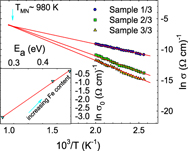Crossref Citations
This article has been cited by the following publications. This list is generated based on data provided by
Crossref.
Crişan, Maria
Răileanu, Mălina
Drăgan, Nicolae
Crişan, Dorel
Ianculescu, Adelina
Niţoi, Ines
Oancea, Petruţa
Şomăcescu, Simona
Stănică, Nicolae
Vasile, Bogdan
and
Stan, Cristina
2015.
Sol–gel iron-doped TiO2 nanopowders with photocatalytic activity.
Applied Catalysis A: General,
Vol. 504,
Issue. ,
p.
130.
Mardare, Diana
Adomnitei, Catalin
Florea, Daniel
Luca, Dumitru
and
Yildiz, Abdullah
2017.
The effect of CO2 gas adsorption on the electrical properties of Fe doped TiO2 films.
Physica B: Condensed Matter,
Vol. 524,
Issue. ,
p.
17.
Crişan, Maria
Mardare, Diana
Ianculescu, Adelina
Drăgan, Nicolae
Niţoi, Ines
Crişan, Dorel
Voicescu, Mariana
Todan, Ligia
Oancea, Petruţa
Adomniţei, Cătălin
Dobromir, Marius
Gabrovska, Margarita
and
Vasile, Bogdan
2018.
Iron doped TiO2 films and their photoactivity in nitrobenzene removal from water.
Applied Surface Science,
Vol. 455,
Issue. ,
p.
201.
Hwang, Keebum
Sohn, Hiesang
and
Yoon, Songhun
2018.
Mesostructured niobium-doped titanium oxide-carbon (Nb-TiO2-C) composite as an anode for high-performance lithium-ion batteries.
Journal of Power Sources,
Vol. 378,
Issue. ,
p.
225.
Mozaffari, Niloofar
Elahi, S Hossein
Parhizgar, Sara Sadat
Mozaffari, Nastaran
and
Elahi, Seyed Mohammad
2019.
The effect of annealing and layer numbers on the optical and electrical properties of cobalt-doped TiO2 thin films.
Materials Research Express,
Vol. 6,
Issue. 11,
p.
116428.
Suwannaruang, Totsaporn
Hildebrand, Josefine P.
Taffa, Dereje H.
Wark, Michael
Kamonsuangkasem, Krongthong
Chirawatkul, Prae
and
Wantala, Kitirote
2020.
Visible light-induced degradation of antibiotic ciprofloxacin over Fe–N–TiO2 mesoporous photocatalyst with anatase/rutile/brookite nanocrystal mixture.
Journal of Photochemistry and Photobiology A: Chemistry,
Vol. 391,
Issue. ,
p.
112371.
Chowdhury, Susmita
Gupta, Rachana
Rajput, Parasmani
Tayal, Akhil
Rao, Dheemahi
Sekhar, Reddy
Prakash, Shashi
Rajagopalan, Ramaseshan
Jha, S. N.
Saha, Bivas
and
Gupta, Mukul
2021.
Detailed Study of Reactively Sputtered ScN Thin Films at Room Temperature.
SSRN Electronic Journal ,
Suwannaruang, Totsaporn
Kidkhunthod, Pinit
Butburee, Teera
Shivaraju, Harikaranahalli Puttaiah
Shahmoradi, Behzad
and
Wantala, Kitirote
2021.
Facile synthesis of cooperative mesoporous-assembled CexSr1-xFexTi1-xO3 perovskite catalysts for enhancement beta-lactam antibiotic photodegradation under visible light irradiation.
Surfaces and Interfaces,
Vol. 23,
Issue. ,
p.
101013.
Chowdhury, Susmita
Gupta, Rachana
Rajput, Parasmani
Tayal, Akhil
Rao, Dheemahi
Sekhar, Reddy
Prakash, Shashi
Rajagopalan, Ramaseshan
Jha, S.N.
Saha, Bivas
and
Gupta, Mukul
2022.
Detailed study of reactively sputtered ScN thin films at room temperature.
Materialia,
Vol. 22,
Issue. ,
p.
101375.
Zhang, Chao
Xu, Kaichun
Liu, Kewei
Xu, Jinyong
and
Zheng, Zichen
2022.
Metal oxide resistive sensors for carbon dioxide detection.
Coordination Chemistry Reviews,
Vol. 472,
Issue. ,
p.
214758.
Kumpook, Saowalak
Tipmongkolsilp, Nutcharnart
Kiatponglarp, Worawikunya
Tanthanuch, Waraporn
and
Pratumyot, Kornkanya
2023.
Influence of level and oxidation state of iron on colors of edible bird’s nest.
Radiation Physics and Chemistry,
Vol. 208,
Issue. ,
p.
110921.
Jiamprasertboon, Arreerat
Waehayee, Anurak
Sertwatsana, Sarunya
Nijpanich, Supinya
Busayaporn, Wutthikrai
Eknapakul, Tanachat
Chanlek, Narong
Bootchanont, Atipong
Sunkhunthod, Chanipon
Watwiangkham, Athis
Nakajima, Hideki
Li, Jun
Subramanian, M.A.
Suthirakun, Suwit
and
Siritanon, Theeranun
2023.
Effects of M cations on crystal structure and optical properties of MTe3O8 tellurites.
Solid State Sciences,
Vol. 135,
Issue. ,
p.
107067.
Stockham, M. P.
Dong, B.
James, M. S.
Zhu, P.
Kendrick, E.
and
Slater, P. R.
2023.
Rapid sintering of Li6.5La3Zr1Nb0.5Ce0.25Ti0.25O12 for high density lithium garnet electrolytes with current induced in situ interfacial resistance reduction.
Energy Advances,
Vol. 2,
Issue. 10,
p.
1660.
Maamoun, Ibrahim
Tokunaga, Kohei
Dohi, Terumi
Kanno, Futoshi
Falyouna, Omar
Eljamal, Osama
and
Tanaka, Kazuya
2023.
Improved immobilization of Re(VII) from aqueous solutions via bimetallic Ni/Fe0 nanoparticles: Implications towards Tc(VII) removal.
Frontiers in Nuclear Engineering,
Vol. 2,
Issue. ,
Deng, Kaixi
Chen, Xiaobo
Moncada, Jorge
Salvatore, Kenna L.
Rui, Ning
Xu, Wenqian
Xiang, Shuting
Marinkovic, Nebojsa
Frenkel, Anatoly I.
Zhou, Guangwen
Wong, Stanislaus S.
and
Rodriguez, José A.
2024.
Observing Chemical and Morphological Changes in a Cu@TiOx Core@Shell Catalyst: Impact of Reversible Metal-Oxide Interactions on CO2 Activation and Hydrogenation.
ACS Catalysis,
Vol. 14,
Issue. 15,
p.
11832.
Bell, Jon G.
Huangfu, Shangxiong
Artiglia, Luca
Graule, Thomas
and
Stuer, Michael
2024.
Hydrogen spillover drives room temperature sensing on spark plasma sintered BaTiO3 with Pt electrodes.
Journal of Materials Chemistry A,
Vol. 12,
Issue. 46,
p.
31993.
Powar, Niket S.
Jang, Myeongjin
Gyu Kim, Min
Hiragond, Chaitanya B.
Lee, Junho
Gong, Eunhee
Kim, Hwapyong
Kim, Dongyun
Jung, Jin-Woo
Cho, Chang-Hee
Zhang, Tierui
Kim, Minho
and
In, Su-Il
2024.
Dynamic Ti3+ and In3+ dual active sites on In2TiO5 to enhance visible-light-driven gas-phase photocatalytic CO2 reduction.
Chemical Engineering Journal,
Vol. 480,
Issue. ,
p.
147966.
Mardare, Diana
Frenti, Mariana
Mita, Carmen
Cornei, Nicoleta
Bulai, Georgiana
Dobromir, Marius
Doroshkevich, Alexandr
and
Yildiz, Abdullah
2024.
Electrical Conduction Mechanism of Mg-Doped ZrO2 Thin Films.
Materials,
Vol. 17,
Issue. 15,
p.
3652.
